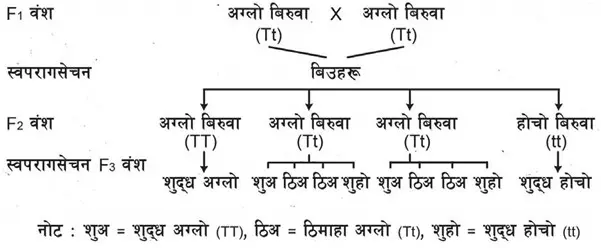2 Marks Question
-
Pea with round seed and wrinkled seed are fertilized and result is shown in
the table. Answer the following questions on the basis of the table.
R r R RR Rr r Rr rr -
- Write phenotype and genotype ratio of round pea and wrinkled pea in that generation.
-
Phenotype = 3:1
Genotype = 1:2:1 - Both law of dominance and law of segregation hold on that result, how?
- While doing the study of both generations, in the first generation there were only pea with rounded seed, where the law of dominance is used. Similarly, the wrinkled pea was also obtained from round pea and we got to know there is also this character which is seen later, where the law of segregation was used.
- Write any two differences between variation and mutation.
-
Any two differences between variation and mutation are shown in table below:
Variation Mutation The morphological changes in the organism due to genetic or environmental changes is called variation. Sudden, spontaneous and drastic heritable changes in an organism is mutation. Variation can be continuous and discontinuous. It is a discontinuous variation. - When a pure pea plant with a red flower is crossed with a pure pea plant with a white flower, what will be the characteristics of offspring in a first filial generation? Explain with reason.
- In the first filial generation, all red flower pea plants are obtained because as described by Mendel's law of dominance white flower pea plant's characteristics are lost in the first filial generation. The red flower is the dominant character and white is the recessive character.
- In a cross between long winged drosophila with short winged drosophila only long winged drosophila were seen in F1 generation. Write its reason.
- In a cross between contrasting characters only one allele of the gene is expressed in F1 generation as a dominant character while the other remains as a recessive character. Between the long wing and short wing, the long wing character is a dominant character while the short wing character is a recessive character. So only long-winged drosophila was seen in F1 generation.
- Write two probable causes that Mendel did not do his experiment in frog instead of pea.
-
Two probable causes that Mendel did not do his experiment in frog instead of
pea are listed below:
- It is difficult to breed in frogs.
- It breeds only in the rainy season, so we can study about only one generation in a year.
- State any two difficulties Mendel would have faced if he had carried out his experiment on humans instead of the pea plants.
-
Any two difficulties Mendel would have faced if he had carried his
experiment on human instead of pea plant are listed below:
- It took many years to get the results of different generation.
- Humans usually produce only one offspring at a time which was difficult to do a comparative study.
- Write a cause of mutation.
- The mutation is caused by the exposure of the body to the harmful radiation like UV rays, X-rays and Gamma ray.
- Write any four generic character found in human.
-
Four generic character found in human are:
Dominant characters Recessive characters Straight thumb Back turned thumb Rolling tongue Not rolling tongue Dense body hair Less body hair Curly hair Straight hair - Show the genotype and phenotype of offspring produced by crossing drosophila with long wings and short wings upto second filial generation.
-
Diagram:

Genotype = 1:2:1
Phenotype = 3:1 - Show the offspring pea plants obtained from the crossing between two hybrid tall pea plants in F1 generation with genotype and phenotype.
-
Diagram:

Genotype = 1:2:1
Phenotype = 3:1 - Write any two difference between monohybrid cross and dihybrid cross.
-
Two difference between monohybrid cross and dihybrid cross is shown below in
table:
Monohybrid cross Dihybrid cross When a cross is made between two pure individuals having or considering a pair of contrasting characters, the cross is called monohybrid cross. When a cross is made between two pure individuals having or considering two pairs of contrasting characters, the cross is called dihybrid cross. Its phenotype ratio is 3:1. Its phenotype ratio is 9:3:3:1. For example: a cross is made between tall and dwarf pea plants. For example: a cross is made between round yellow seeded pea plant and a wrinkled green seeded pea plant.